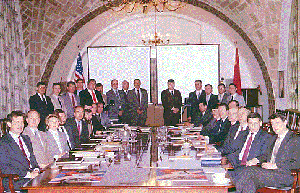| Joint U.S./Soviet Techincal Talks | ||
 In the Spring of 1988 the treaty signatories held a series of INF Treaty Technical Talks. The U.S. and Soviet delegations shown here met at the National War College in Washington, D.C. in April 1988. |
As they
responded to this blitz of questions about the treaty and
OSIA's operational and organizational activities, General
Lajoie and key senior officers also participated in a
series of U.S.-Soviet "technical talks" held in
Moscow, Washington, and Vienna in March, April, and May
1988. The agenda for the bilateral meetings focused on
implementing the on-site inspection provisions of the
treaty. During treaty negotiations U.S. and Soviet
negotiators had acknowledged that certain practical and
procedural issues--flight call signs, diplomatic visas,
communication message formats, and other matters--were
best left out of the treaty text. These issues would be
resolved informally in a series of meetings between
representatives of the two governments once the treaty
had been signed. Each of the three meetings lasted a
week; cumulatively they resulted in a range of joint
decisions on procedural issues.13 Led by General Lajoie and General Major Vladimir I. Medvedev, these technical talks resolved more than a hundred issues on how the two nations would carry out their treaty-specified rights and responsibilities. In March in Moscow, the two delegations agreed on standardizing the photographic and measuring equipment taken to the site by the inspection teams and they discussed how notifications of arrival and departure of the teams would be handled. At these meetings, the leaders and their 13-member delegations resolved 46 issues, including procedures for operating, landing, and refueling INF aircraft flying into and out of each nation's treaty-designated entry points. They agreed that inspectors could have a notebook, paper, writing instruments, flashlight, and hand-held compass. All inspection teams would have uniform weighing and measuring equipment. The initial portal monitoring on-site inspection operations at Votkinsk and Magna were discussed extensively.14 At a separate U.S.-USSR conference in Washington in April, specific formats for INF Treaty messages were developed; these messages would be sent and received through the respective Nuclear Risk Reduction Centers (NRRCs). |